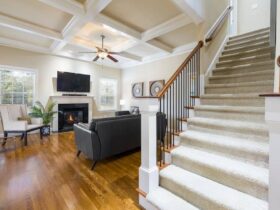Creating an exclusive home means having complete control over every design aspect. There are a dozen of common architectural styles to build upon, from a historical perspective to a modern interpretation, with a traditional home as a base. Look across the country, and you’ll see almost countless options. In the Northeast, Colonial-style houses and Cape Cods dominate the environment. The west has some of the best craftsmen and regions, while the south has some of the best Greek Revival homes. The beauty of building a traditional home lies in the freedom to choose the right architectural style that is practical and pretty fun.
Common Architectural Styles for Your Custom Home
There are many ideas used to design special homes. Certain climates are more suitable for certain home designs. A home may have a special roof area suitable for snowy winters or a yard great for sunny weather. The surrounding landscape and neighboring buildings are also huge factors when choosing a common architectural styles for traditional homes. While it is always difficult for a particular home to decide on the final design, design inspiration can help narrow down the options. It would be very helpful to look at some of the most common architectural styles in this country when designing traditional homes. This article will summarize each style by giving several historical backgrounds, general characteristics, and examples.
Cape Cod is a classic home style from the late 17th century. When the Puritan invaders moved to New England, they built a half-timbered house that could withstand the harsh weather. This house was first seen in Massachusetts, and the original area would be named Cape Cod.
Characteristics of Cape Cod Home:
Pastor Timothy Dwight is the first to describe Cape Cod homes in detail. He observed that these houses were made of oak or deodar trees, readily available and sustainable resources to endure winters. These houses have low roofs to avoid snow build-up on the roof and to conserve heat from the inside. The central chimney is another important Cape Cod household feature.
The Cape Cod style has evolved throughout the years, and there are three variations: half robe, three-quarters of the Cape, and full cape. The half cape or single Cape is the simplest variation and an early example of a Cape Cod-style house. The front door and two multi-sill windows on the other side can be marked this. As the years passed, the family grew, and half the robbers spread to three-quarters of the robe. Like a half-robe, three-quarters of the cap was found on the side of the house, and the front door was found, with two multi-sill windows and windows on the other side. Complete Cape houses existed during the 18th century, but the wealthy only used this style. Unlike the half-and-three-quarters from the Cape, the Full Cape House has a front door with a symmetrical window on each side.
Example of a Cape Code Home:
The Cape Cod style is still a popular choice for many landlords, and architect Royal Barry Wills can be credited with the 20th-century revival. Wills is known as the father of the Revival Cape Cod. Local Massachusetts crafted the perfect plan for families looking for a classic suburbia getaway. He made his plans readily available to many families, even selling his destination plans for a dollar. His efforts to make the Cape Cod style more easily accessible made it popular in suburban environments.
Actor Dakota Fanning’s newborn purchased a traditional Cape Cod house in Valley Village, Los Angeles, for $2.95 million. This 4,428 square foot has five bedrooms and six bathrooms. Guests entered the middle hall with a double centerpiece with a beautiful chandelier as the midpoint. The carved metal fireplace will surely attract attention from the large central hall to the formal living room. The living room leads to a formal dining room decorated with crystal lights. The second floor features an impressive master suite, with the main bathroom with a temple fireplace, balcony, walk-in closet, and glass-filled steam bathroom.
Example of a Colonial Home:
Initially built in the 1940s, this Colonial home was bought by its homeowners because they were fascinated by its large backyard and outdoor ponds. The interior is very old, but the homeowner wants to revive forgotten characters from his Colonial home. The owner of DPR hired Jeff Trier Associates to complete the remodeling of the entire house. The result is a two-phase plan that lasts about ten years.
The beautiful colonial exterior is given a modern update that still retains the original home’s essence. Blue tiles are a good complement to the white exterior. Inside, a loft second floor is added. Maintaining a low exterior ceiling is challenging when building additions to the troughs. But the result is a trendy space that’s the ideal place for book pests. When guests climbed the stairs, they were greeted by a special bookshelf mounted on the walls. The company ensures that the library and home office are well lit by placing a curved window facing the swimming pool.
Characteristics of a Craftsman Home:
The Craftsman’s House emphasizes natural ingredients and has a symmetrical structure. It has a low-pitched roof with gables HIPD, overhanging events, and a wide front porch with slender columns or parades that extend to the ground. Stone and handmade woodwork are also common elements. This style lends a special color combination to the home.
The Craft House features a concise, open interior that promotes better traffic and family interaction. Specialties such as default furniture, bookshelves, cabinets, and even food angles are Craftsman homes. Story House, Bungalow, and Style Craftsman emphasize natural ingredients such as wood, stones, and bricks. They feel comfortable being at home and being rich in detail.
Example of a Craftsman Home:
Gamble House is one of the most famous craftsmen in the country. Gumball’s house was designed by the Green & Green Architectural Company from 1908 to 1909. It was supposed to be a winter home for David’s husband and wife and Mary Gumball. Gamble House is the best Arts and Crafts house. It uses natural ingredients and has unparalleled expertise that is replicated today. Everything about the home reflects an early Craftsman style pillar. Green builds every habit of the household to meet the rural base.













